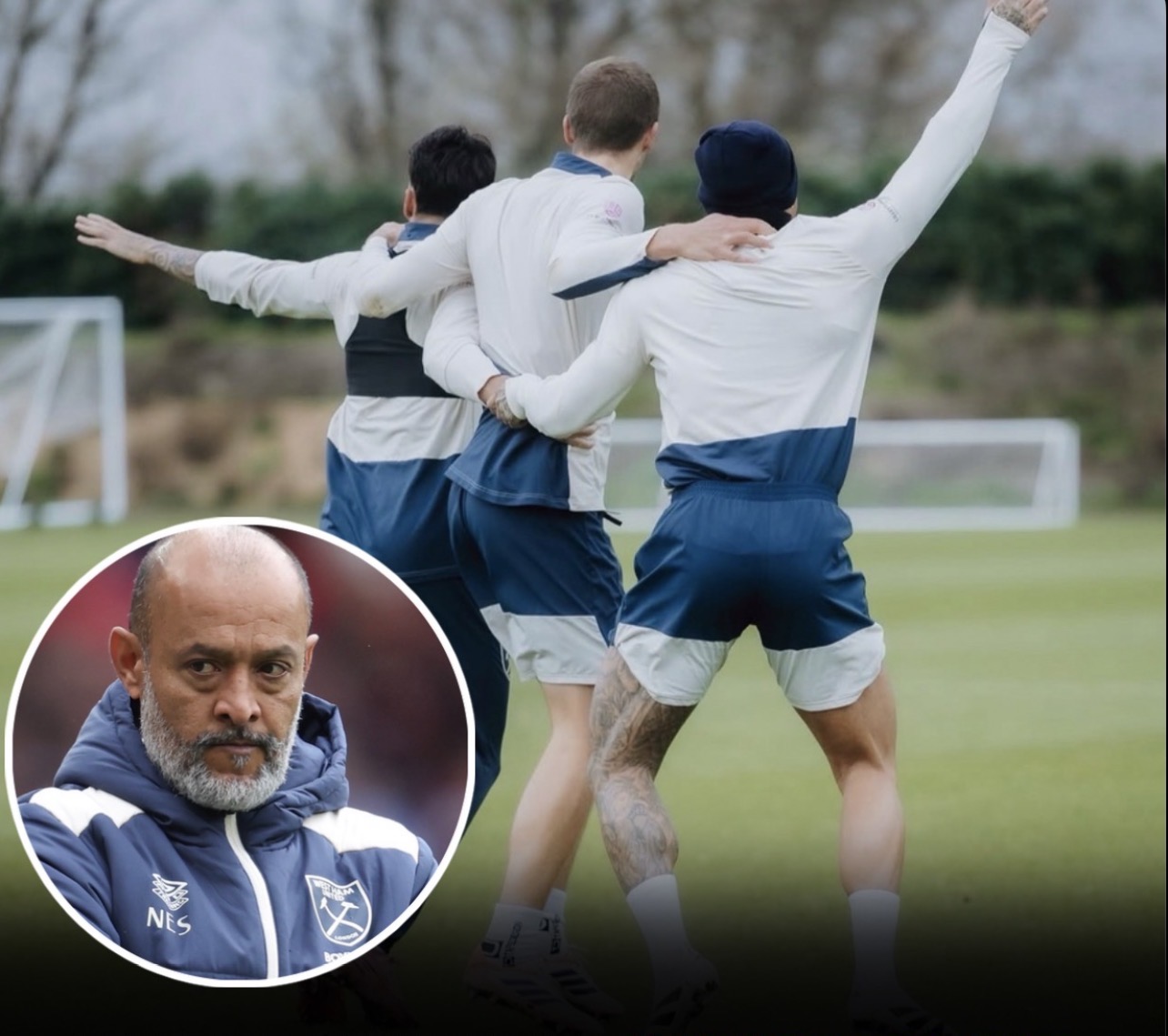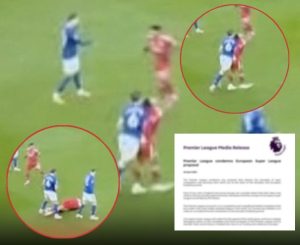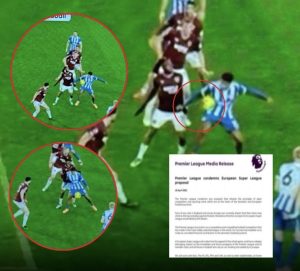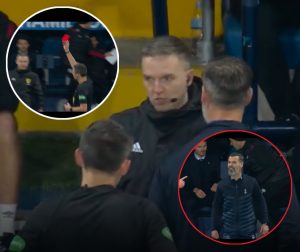REASON WHY PENALTY WAS GIVEN DESPITE IT’S NOT A FOUL HAS LEFT EVERYONE FURIOUS — FA RELEASES SHOCKING STATEMENT
Football fans across England have erupted in anger after a highly controversial penalty decision during the Bournemouth vs West Ham clash, a decision that shifted the momentum of the entire match and ultimately shaped the final 2–2 result. What should have been a routine defensive situation became the spark for a nationwide debate, with supporters, pundits and former referees all weighing in on what many are calling one of the softest penalties awarded in recent Premier League history.
The uproar intensified even further when the FA released an unexpected statement shortly after the match, attempting to explain why the penalty was awarded despite replays appearing to show little to no contact. Instead of calming tensions, the statement has only added fuel to the fire, leaving fans more furious and confused than before.
This incident, occurring in a match where Bournemouth desperately needed a result and West Ham were fighting to hold onto a well-earned lead, has quickly become the biggest talking point of the Premier League weekend.
A MATCH THAT HAD EVERYTHING — EXCEPT REFEREEING CONSISTENCY
The game began brightly. West Ham looked sharp, clinical, and decisive in the first half, finding the net twice through well-worked attacking movements that left Bournemouth scrambling. Bournemouth, on the other hand, pushed back aggressively, refusing to roll over in front of their home supporters.
But the match’s defining moment came in the 69th minute — not from brilliance, not from a defensive lapse, but from a refereeing decision that has left a lasting scar on the fixture.
Bournemouth were attacking down the left, a bouncing ball found its way into the box, and a West Ham defender stretched to challenge. The Bournemouth attacker went down, but replays clearly showed what appeared to be minimal, if any, meaningful contact.
The West Ham bench erupted immediately. The away fans could hardly believe what they were seeing. Even the Bournemouth supporters seemed slightly surprised when the referee pointed straight to the spot.
But the real firestorm kicked off seconds later when VAR, after a surprisingly brief review, affirmed the on-field decision.
THE FOOTAGE THAT ENRAGED FANS AROUND THE WORLD
Slow-motion replays that circulated online within minutes painted a picture that fans were quick to interpret as a blatant injustice. In one angle, the Bournemouth player seems to initiate the movement toward the defender. Another camera view shows the defender pulling his foot away at the last second. A third frame shows the attacker going down before clear contact is made.
The viral freeze-frames posted by major football pages captured the moment perfectly — or disastrously, depending on who you support.
Thousands of fans on social media questioned how VAR, with multiple angles and the benefit of slow-motion, could possibly categorize the moment as a foul worthy of a penalty.
Phrases like “daylight robbery,” “utter disgrace,” “the game’s gone,” and “VAR is killing football” dominated fan comments for hours after full-time.
THE FA’S SHOCKING STATEMENT — AND WHY IT ONLY MADE THINGS WORSE
In an incredibly rare move, the FA released a statement addressing the controversy. But instead of providing clarity, reassurance, or a sense of fairness, their explanation left fans even more bewildered.
The FA’s key justification hinged on one phrase:
“The on-field decision was not based solely on physical contact but on the defender’s impeding action, which was deemed sufficient to disrupt the attacker’s progression.”
In simple terms, the FA claimed the penalty was given because the defender’s movement created an impediment, even if there was insufficient physical contact.
This was interpreted as a dramatic shift in how fouls inside the box are judged.
Fans, pundits, and ex-pros immediately labeled the reasoning as vague, inconsistent, and dangerously ambiguous. Many argued that almost every defensive action—successful or not—could now be categorized as “impeding,” potentially leading to an avalanche of soft penalties in future matches.
PUNDITS AND ANALYSTS TEAR APART THE DECISION
The football world did not hold back in dissecting the FA’s explanation.
Neutral analysts questioned how a game already plagued by VAR confusion could benefit from adding another layer of subjective interpretation. Some argued that the FA’s wording essentially gives referees full freedom to award penalties based on perceived intention rather than actual contact.
Former referees also chimed in, saying that while “impeding without contact” is part of the rulebook, it is almost never applied in this manner — certainly not in situations where the attacker appears to be falling before any clear obstruction occurs.
Others argued that if the same incident happened in the middle of the pitch, the referee would not even consider blowing for a foul, let alone stopping the match for a penalty.
THE IMPACT ON THE MATCH — AND THE TABLE
The penalty was converted confidently, swinging the match back in Bournemouth’s favour and sparking a furious reaction from West Ham players. Bournemouth later found another equalizer in the 81st minute, completing a comeback that might not have been possible without the controversial spot-kick.
West Ham fans have pointed out that their team lost full momentum after the penalty decision, claiming the psychological blow was more damaging than the actual goal.
On the other side, Bournemouth supporters argue that they still needed to finish their chances — and they did — meaning the draw was earned, regardless of the controversy.
FANS CALL FOR RULE CHANGES — AND VAR REFORM
In the aftermath of the match, calls for major re-evaluation of VAR protocols echoed across fan forums and sports media outlets. Many supporters argue that VAR should no longer have the authority to confirm subjective decisions such as minor contact or “impeding,” instead limiting its power to clear, objective errors.
Ideas being proposed by fans include:
- Requiring referees to watch incidents in real-time speed rather than slow-motion.
- Forcing VAR to overturn decisions unless clearly indisputable.
- Removing the “clear and obvious” standard and replacing it with a more transparent threshold.
- Allowing managers or teams a limited number of VAR challenges per match.
Whether any of these ideas gain traction remains to be seen — but the pressure is mounting.
THE BIGGER QUESTION — WHAT IS A FOUL NOW?
The FA’s explanation has created an unexpected philosophical debate in the football world. If physical contact is no longer a requirement inside the penalty area, and defenders can be penalized purely for obstructive movement, then defending becomes nearly impossible.
Players may soon hesitate to extend their legs, jockey for position, or even track runners in the box for fear of being punished for “impeding.”
The Bournemouth vs West Ham incident may go down as a watershed moment, remembered as the point where fans collectively demanded the sport rethink the entire concept of fouls, penalties, and officiating consistency.
CONCLUSION — THE AFTERMATH OF A DECISION THAT WON’T BE FORGOTTEN
The match ended 2–2, but the debates, frustration, and controversy will linger long after the final whistle.
In an era where VAR was supposed to eliminate bias, mistakes, and uncertainty, fans instead feel more alienated than ever. The FA’s explanation, rather than calming the storm, has sparked even more outrage — and the conversation is far from over.
One thing is certain: this decision will be studied, debated, and referenced for months to come, especially if similar incidents follow. Football is at a crossroads, and unless the rules are clarified, moments like these will continue to overshadow the beauty of the game.








Post Comment